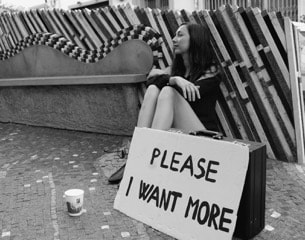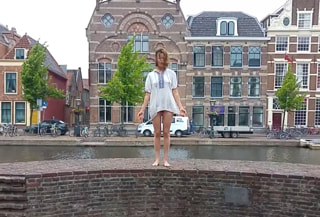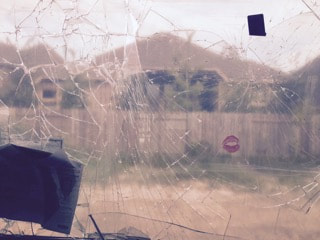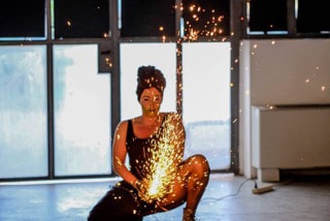Location: Between Present and Future
curation and text by Jeanette Joy Harris
Our Prime Property (OPP) asks artists to consider where a work can exist in perpetuity. When asked to curate, I decided to select a series of performances knowing that location, a central idea in OPP’s project, is a fundamental but sometimes controversial component for performance art. In this collection of four works, I look at location where performances occur and where they then can be ‘stored’ or archived.
Location can encourage, determine, and/or undermine a work. It provides an aesthetic quality situated within material constraints. It articulates political and social conditions, both explicitly and implicitly. It can pose physical danger to the artist and/or threaten to silence her expression. Choosing a location is integral to the performance process because it helps to shape the work itself. That is to say, artists are always considering where a performance is to be shown but the location itself is never ideal, nor does it need to be. The location needs to provide an environment where an idea can unfold, where the space and the work are in dialogue.
And then there is the question of where a work of performance should be ‘stored’ or ‘archived. Art historians wrangle with how to document a performance. Videos or photographs do little to convey the immediacy of a work and yet those media and ephemera are the only objects that can serve as testament to an event that had a discrete beginning, middle, and end. But even if those pieces could be pulled together to re-perform the work, is it the same work at all?
So, If OPPs' objective is to articulate ideal locations, performance poses a problem because a performance does not rely on an ideal condition and a performance cannot be stored and then duplicated in the future.
What then of this collection of works, subtitled “Between Present and Future?” They demonstrate ways in which location informs a work and how the suitability of location might or might be ideal for current or future performances.
Click image below or blue text to go to full description of Mrovlje
Location can encourage, determine, and/or undermine a work. It provides an aesthetic quality situated within material constraints. It articulates political and social conditions, both explicitly and implicitly. It can pose physical danger to the artist and/or threaten to silence her expression. Choosing a location is integral to the performance process because it helps to shape the work itself. That is to say, artists are always considering where a performance is to be shown but the location itself is never ideal, nor does it need to be. The location needs to provide an environment where an idea can unfold, where the space and the work are in dialogue.
And then there is the question of where a work of performance should be ‘stored’ or ‘archived. Art historians wrangle with how to document a performance. Videos or photographs do little to convey the immediacy of a work and yet those media and ephemera are the only objects that can serve as testament to an event that had a discrete beginning, middle, and end. But even if those pieces could be pulled together to re-perform the work, is it the same work at all?
So, If OPPs' objective is to articulate ideal locations, performance poses a problem because a performance does not rely on an ideal condition and a performance cannot be stored and then duplicated in the future.
What then of this collection of works, subtitled “Between Present and Future?” They demonstrate ways in which location informs a work and how the suitability of location might or might be ideal for current or future performances.
Click image below or blue text to go to full description of Mrovlje
I am closing this exhibition with the work The Constant State of Emergency by Ana Mrovlje. In this multi-day performance, Mrovlje moved from place to place, assuming the role of a beggar. Paradoxically, location becomes both an essential and arbitrary component to the performance. While the location determines what kind and how many people will see her work, her desire to transform spaces, to devolve them to something previous, is not contingent upon any particular place.
Mrovlje's work, as an ontological process, is not site specific yet its outcome can yield experiences that tap into the many concrete ways we see ourselves and interact with others. “Please I want more,” the sign she uses, could be a pleading from a vulnerable person or the battle cry of a group of protestors. The Constant State of Emergency reminds us of our dual identity as both individual and collective.
More broadly, The Constant State of Emergency as a portable work, residing in a location of specificity and universality simultaneously, points to even larger conversations around what we want more of as people in a shared world. It would be easy to see the work as a simple meditation on greed and poverty, because Mrovlje assumes the status of a beggar, but I believe the work is more than that. The Constant State of Emergency also reminds us of the personal and humanitarian struggles that surround us. Though we may not know what 'more' is for others, we can reflect upon that feeling ourselves and take action to alleviate the distress we see in the world. If, as Mrovlje writes, enantiodromia is about the natural process of oppositional change, then I hope The Constant State of Emergency is a catalyst for deeper sympathy in a troubled time.
Larysa Bauge’s DONA is a series of works whose resonance is amplified by location. Performed in four sections, DONA takes place in a posh neighborhood in The Hague (The Netherlands) where Bauge takes advantage of quiet streetscapes and canals. The work named for the dona nobis pacem (grant us peace) from the Agnus Dei points less to a religious beckoning and more to a yearning for acknowledgement and comfort as Bauge performs her site specific actions in both the presence and absence of the people around her.
I chose DONA for this show because the streetscapes where Bauge’s works take place perform both architecturally and psychologically, providing nuanced dimensionality to the simplicity of her actions. For example, in her first action, the canal provides an obstacle for her to overcome while in the third action it provides a tranquil backdrop where we can focus on the crescendo of her voice. In all ways, the presence of the canal reminds us of the constant movement of people, pointing to one of Bauge’s deeper themes of immigration.
DONA was developed during research she was conducting on trauma and genetics at the BioScience Institute (Leiden), DONA was performed in June 2016 in Leidse Schouburg over four days and then summarized by video (shown here) inside a theatre.
This is where I would cook you dinner was chosen as part of this show because it is a performance that occurs in a non-place, a home under construction. Buildings under construction exist in a constant state of physical becoming and a state of emotional anticipation. As the house is being built, the owner sees what will be completed, not the framing, exposed plumbing lines and gaps where windows will be installed. The site of construction is never identified as a true location until its owner walks across the threshold to create her memories within it.
As the performance occurs, you can view the action in two ways: as it exists in its raw location or what it might be like if the space were completed. Audience engagement is doubled as you consider it from the builder’s point of view – a work that becomes more valuable as each layer is completed – or from the prospective owner’s point of view – a home that becomes more valuable as its moves away from its structural pieces and toward a place where a future life can be made. And, yet, the work also reminds us of those hidden layers, though covered up by paint, are inextricable from the construction itself.
After entering a house under construction, Harris kisses locations throughout the wooden structure only to then smear away the lip marks. The action ends when she writes in the kitchen – in lip liner - this is where I would cook you dinner.
Giorgia de Santi asked the organizers of Italia Drag Queen contest at Pride Village Padova if she could be a contestant. She was denied participation because the rules required contestants be male. PLEASE pay in-attention PLEASE is an action that responds to Italia Drag Queen’s regulations and broader ideas of gender identity and inclusion.
The work exists in several parts, beginning with the request to participate in the show followed by actions by Giorgia de Santi with Sabrina Bellenzier:
- Conversations with other artists about the contest’s policy, which then yielded written reflections.
- Writing these reflections inside Pride Village until the artists were removed.
- Continuing the action outside the entrance of Pride Village.
I chose to begin this series with de Santi’s PLEASE pay in-attention PLEASE because her relationship with location is nuanced. Per OPP’s directive, Pride Village Padova should be an idealized space for a conversation around gender but when de Santi’s request for participation in the Italia Drag Queen contest was denied, she had to determine a new location for her work.
I am interested in de Santi’s work because despite its social and political context it is quiet and deeply tender (using her own words). When reaching out to Italia Drag Queen she didn’t necessarily want to participate in the show but, rather, she wanted to “challenge the organizers and understand their reflection upon Lgbtqi+ inclusion.”
In PLEASE pay in-attention PLEASE de Santi replaces the noise and chaos of a beauty contest with thoughts that are deeply personal. Instead of using the contest as a moment for protest, she used it as an opportunity to create a location for reflection and conversation.



